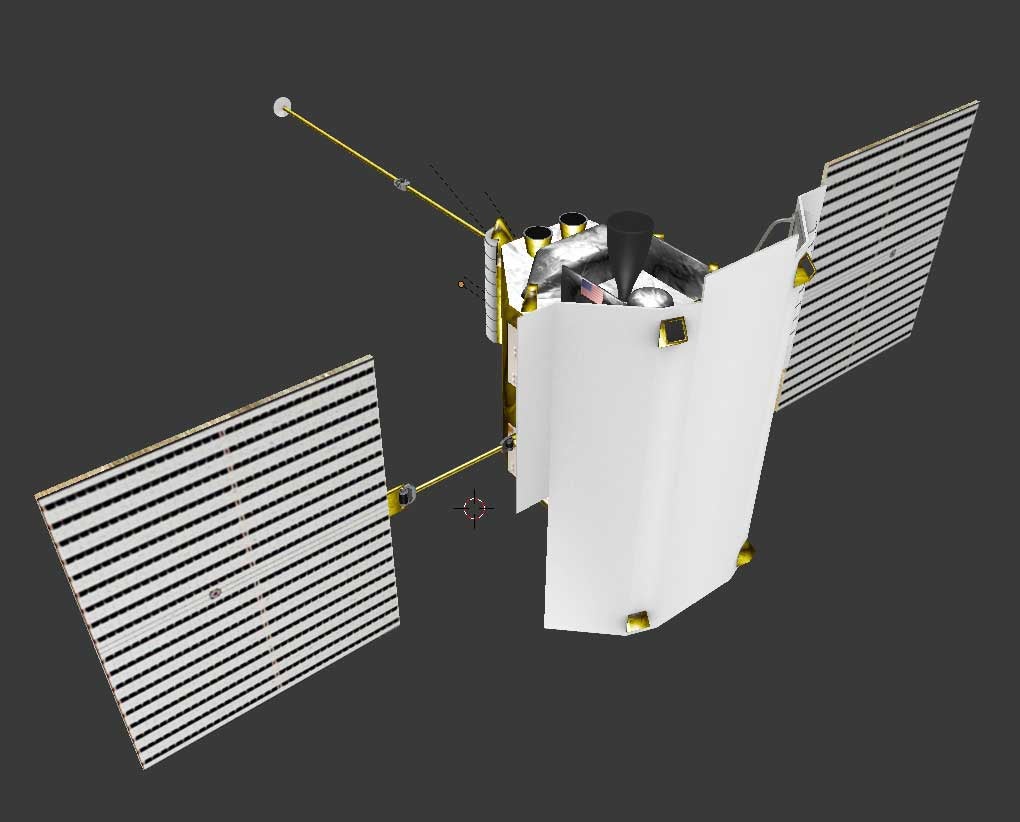A highly accurate OCM executed on January 21 targeting a 9-mile (15 kilometers) periapsis altitude — the lowest to date — set the stage for the hover campaign in a short extension of the Second Extended Mission termed XM2-Prime (XM2’). The top science goals for XM2’ will be carried out with the Magnetometer (MAG) and the Neutron Spectrometer (NS), and each instrument will target different objectives in different regions, said Haje Korth of The Johns Hopkins University Applied Physics Laboratory (APL) in Laurel, Maryland.
“With MAG, we will look for crustal magnetic anomalies,” he said. “For instance, we have seen hints of crustal magnetization at higher altitudes — ~40 miles (70km) — over the northern rise in Mercury’s northern smooth plains. We will revisit this region at lower altitudes during XM2’. There may be other regions where such signals can be observed, and we will be looking for them.”
“With NS, scientists will hone in on shadowed craters at northern high latitudes to search for water ice,” Korth said. “We have found such evidence previously in the mission, but we hope to find more at low altitudes and spatially resolve the distribution within individual craters if we are lucky.”
According to Korth, the observations enabled by this “saving throw” are no less significant than earlier ones. “Establishing the presence of crustal magnetic anomalies on Mercury would be a huge result because it would extend the known temporal baseline for Mercury’s internal magnetic field by eight orders of magnitude,” he said. “Moreover, observing any such anomalies at different altitudes will allow the depth of the source to be determined.”
“Since the periapsis altitude during the hover campaign is ~20 miles (30km) or less throughout XM2,’ we will have the opportunity to map half the planet with a magnetic magnifying glass, so to speak,” Korth said. “There are regions we have never seen at such low altitudes and multiple areas of magnetic anomalies may be detected.”
Staying aloft
The ever-present tug of the Sun’s gravity continues to perturb the spacecraft’s orbit and drive closest approach downward toward the planet surface. For the last few weeks, MESSENGER’s altitude at closest approach has remained between 3 and 11 miles (13 and 17 km). To extend this hover campaign as long as possible, MESSENGER’s mission design team optimized the trajectory design and the placement of each orbit-correction maneuver.
“We decided on a strategy that includes five maneuvers in as many weeks to keep the spacecraft within a tight altitude range of 3 to 24 miles (5 to 39 km) above the surface of Mercury at closest approach,” said Jim McAdams from APL.
Four of these five maneuvers occur in situations different from the dawn-dusk orbit orientation used for all earlier orbit-correction maneuvers in the mission, McAdams said. “During the interplanetary cruise phase, we designed similar course-correction maneuvers consisting of two or three separate, closely spaced maneuvers accomplished with different thruster sets. For XM2’, we simplified the design and implementation of the final maneuvers so that each will be executed at a single spacecraft orientation using one thruster set to maximize the orbit altitude change per unit mass of propellant consumed.”
The maneuvers are not without risk, McAdams said. “Increased uncertainty associated with effects on the spacecraft orbit of Mercury’s gravity field at lower-than-ever altitudes, challenges in accurately predicting the spacecraft orbit when the Sun is near the spacecraft-to-Earth communications direction, and implementation of frequent OCMs make for a challenging final few weeks of flight operations,” he said. “Depending on how each maneuver goes and on how Mercury’s gravity field affects the minimum orbital altitude, we may need to plan and implement a contingency maneuver. Inserting a contingency maneuver will increase the likelihood of the hydrazine propellant running out earlier than planned.”
So far, so good
This first maneuver went as planned. At the time of this most recent operation, MESSENGER was in an orbit with a closest approach of 7.2 miles (11.6km) above the surface of Mercury. With a velocity change of 6.87 miles per hour (3.07 meters per second), the spacecraft’s four largest monopropellant thrusters (with a small contribution from four of the 12 smallest monopropellant thrusters) nudged the spacecraft to an orbit with a closest-approach altitude of 21.4 miles (34.5km).
This maneuver also increased the spacecraft’s speed relative to Mercury at the maximum distance from Mercury, adding about 1.1 minutes to the spacecraft’s eight-hour, 16.5-minute orbit period. OCM-13 used propellant from the small auxiliary fuel tank.
MESSENGER was 115.4 million miles (185.6 million km) from Earth when the 32-second maneuver began at 11:00 a.m. EDT. Mission controllers at APL verified the start of the maneuver 10.3 minutes later after the first signals indicating spacecraft thruster activity reached NASA’s Deep Space Network tracking station in Goldstone, California.
The next maneuver, on April 2, will again raise the spacecraft’s minimum altitude, allowing scientists to continue to collect images and data from MESSENGER’s instruments.










